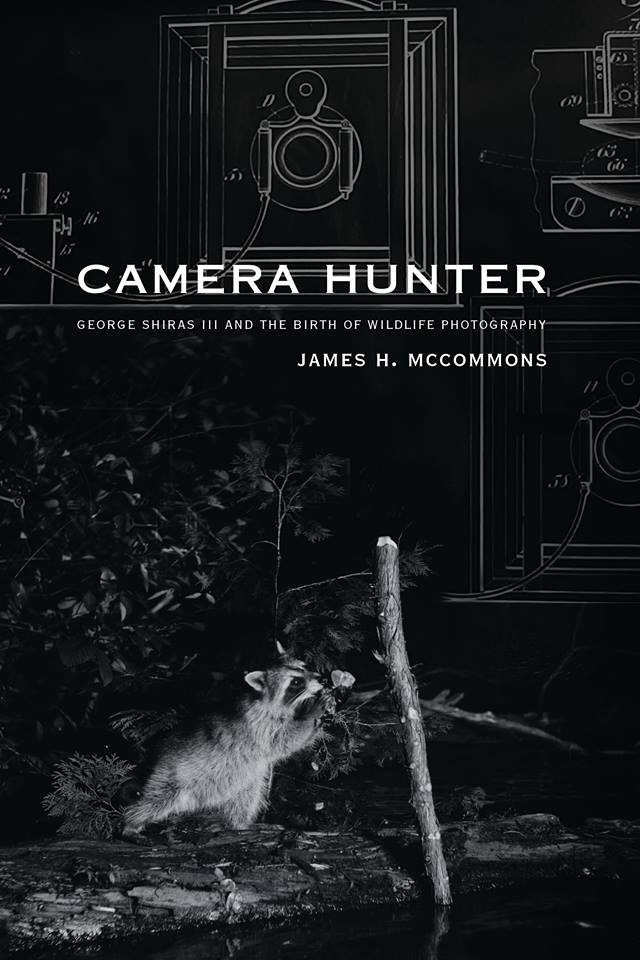Trail cameras detect some of the most fascinating, unedited elements of the natural world. Across the U.P., trail cameras capture a vast amount of wildlife attraction from mountain lions, bear cubs to wolf packs. And as many hunters get ready to hit the woods this season in search of the biggest buck, some rely on trail cameras to configure where the best hunting locations might be. And it all began with a man named George Shiras III.
NMU English professor and author James McCommons released a new biography last week titled “Camera Hunter: George Shiras and the Birth of Wildlife Photography” and will give a talk at 7 p.m. on Thursday, Oct. 10 at the Ore Dock Brewing Co. as part of Science on Tap “George Shiras III vs. the Nature Fakers.”
This book is right up the alley for both hunters and conservationists, McCommons said.
“There’s a lot of U.P. stuff in this book. Although it ranges out to other places like Florida and Yellowstone, I think in a national significance it’s good for folks to know who Shiras was, how he fit into this period and I also think wildlife photography is a pursuit done all over the world,” McCommons said. “This was the man who was basically one of the fathers of wildlife photography.”
The event will focus on the time period from 1903 to 1907, where Shiras and other naturalists including President Theodore Roosevelt took part in a war of words with animal fiction writers, and battled fiction depicting or what some called “yellow journalism of the woods” in newspaper and magazine articles, McCommons said.
When McCommons first came to NMU 20 years ago, he said he noticed the vast amount of places in Marquette named after Shiras and after discovering Shiras’ book “Hunting Wildlife with Camera and Flashlight” at a used book store, he was intrigued to go on a literary hunt. Setting out to write this book, McCommons did eight years of tedious research, visiting archives of the University of Pittsburgh, Yale University, Library of Congress and the Smithsonian. Being that Shiras was a Congressman, most of his papers were in Washington D.C. so the research process required tracking down written letters and gathering all the little pieces to add to the puzzle.
Writing a biography differs from writing an autobiography, in the sense that McCommons had to rely on documents compared to real-life interviews. Through this rigorous hunt to sort out all of the documents, McCommons said he learned to be both a writer and editor and spent many years reviewing and rewriting.
“To me, I’ve been an academic for 20 years so this is truly a book done by an academic for an academic press. I think it’s a pretty good read too. It’s a good story, George lived an adventurous life and that part was fun to write,” he said.
Shiras pioneered the trail camera at his deer camp on Whitefish Lake, about 20 miles east of Marquette, in the 1890s using wire and baited string to trip a camera shutter and a chemical flash, McCommons continued. Many people were exploring photography during that time period but Shiras was the first nighttime wildlife photographer, McCommons said, explaining, Shiras would go out late at night and keep his ears open on any animal movement on shore.
Once an animal was detected, Shiras would “creep” up with his canoe and stand up, holding a chemical flash and “blast” it off. The noise erupted the whole forest like a “percussion grenade,” lighting up the woods for a brief moment.
Photographing in that era was a hit and miss process, and it all depended on the timing of the shutter of the camera and the time the flash went off, McCommons said.
It took Shiras three years to photograph his first nighttime image of a deer, and his photographs were the first wildlife stills published in the National Geographic magazine in 1906.
“[Shiras] had a good eye for composition. The images are actually quite beautiful. They’re not just pictures of animals, they’re art and so I think the book is going to get some attention nationally,” he said.
Though originally from Pittsburgh, Shiras’ family were avid fishermen and enjoyed coming up to the U.P. where they became good friends with one of Marquette’s founders Peter White, and Shiras ended up marrying White’s daughter. Throughout the Progressive Era, Shiras worked tirelessly alongside other conservationists to help preserve habitats and save endangered species, but at the time of his death, many people had forgotten about Shiras, McCommons said, adding that he wanted to write a book that “cemented” Shiras’ work.
“It’s nice to feel that this is a historical book about a figure in Marquette and in the U.P. that people need to know about. I think that this is a book that’s going to go on a shelf and 100 years from now when somebody wants to know who this guy, they can take that book down and it’s all there,” McCommons said.
Following the Ore Dock event, McCommons will speak at 7 p.m. on Tuesday, Oct. 15 in the Community Room at Peter White Public Library. McCommons’ book is now on sale at Snowbound Books and copies can be purchased at the U.P. Regional History Center, Canterbury Book Store In Escanaba, Amazon or through the University of New Mexico Press.






























